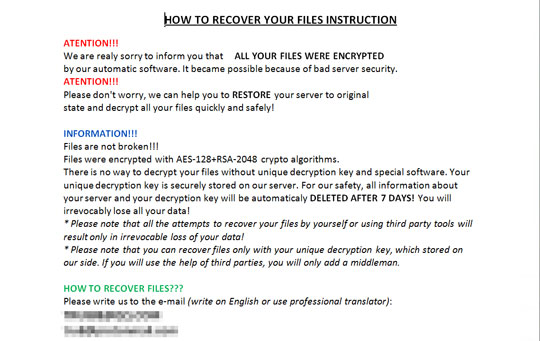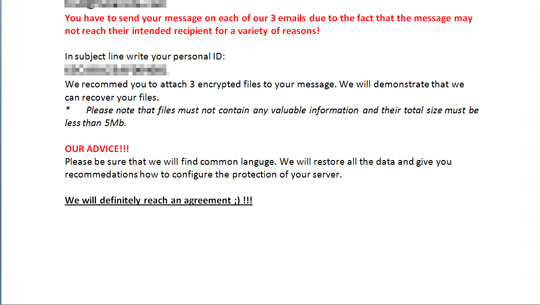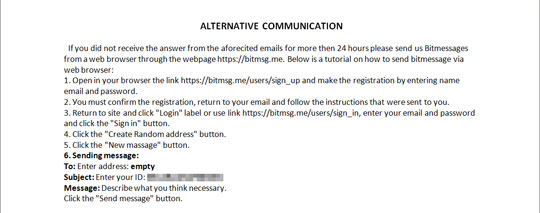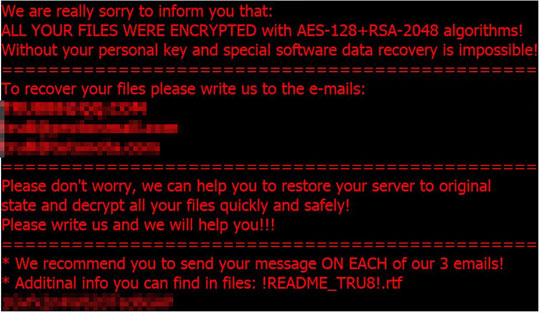Ransom.Win32.MATRIX.AQDEE
Ransom:Win32/Gansom.AB!MSR (MICROSOFT); HEUR:Trojan-Ransom.Win32.Agent.gen (KASPERSKY)
Windows


Threat Type: Ransomware
Destructiveness: No
Encrypted: Yes
In the wild: Yes
OVERVIEW
This Ransomware arrives on a system as a file dropped by other malware or as a file downloaded unknowingly by users when visiting malicious sites.
It connects to a website to send and receive information.
It avoids encrypting files with the following file extensions.
TECHNICAL DETAILS
Arrival Details
This Ransomware arrives on a system as a file dropped by other malware or as a file downloaded unknowingly by users when visiting malicious sites.
Installation
This Ransomware drops the following copies of itself into the affected system:
- {Malware directory}\{random characters}.exe
It drops the following files:
- %System%\Drivers\PROCEXP152.SYS
- {Malware directory}\{random characters}.exe → used for file handle manipulation
- {Malware directory}\ALL_dmp.fldp
- {Malware directory}\log.txt
- %Application Data%\{random characters}.bmp → used as wallpaper
- %Application Data%\{random characters}.bat → contains commands to remove volume shadow copies and disable system recovery
- %Application Data%\{random characters}.vbs → contains commands to create scheduled task
- {Malware directory}\{random characters}.bat → contains commands to take ownership of a file
(Note: %System% is the Windows system folder, where it usually is C:\Windows\System32 on all Windows operating system versions.. %Application Data% is the current user's Application Data folder, which is usually C:\Documents and Settings\{user name}\Application Data on Windows 2000(32-bit), XP, and Server 2003(32-bit), or C:\Users\{user name}\AppData\Roaming on Windows Vista, 7, 8, 8.1, 2008(64-bit), 2012(64-bit) and 10(64-bit).)
It adds the following processes:
- "%System%\cmd.exe" /C copy /V /Y "{Malware directory}\{malware name}.exe" "{Malware directory}\{random characters}.exe";
- "{Malware directory}\{random characters}.exe" -n;
- %System%\cmd.exe" /C reg add "HKCU\Control Panel\Desktop" /v Wallpaper /t REG_SZ /d "%Application Data%\{random characters}.bmp" /f & reg add "HKCU\Control Panel\Desktop" /v WallpaperStyle /t REG_SZ /d "0" /f & reg add "HKCU\Control Panel\Desktop" /v TileWallpaper /t REG_SZ /d "0" /f;
- "%System%\cmd.exe" /C wscript //B //Nologo "%Application Data%\{random characters}.vbs";
- "%System%\cmd.exe" /C schtasks /Create /tn DSHCA /tr "%Application Data%\{random characters}.bat" /sc minute /mo 5 /RL HIGHEST /F;
- "%System%\cmd.exe" /C schtasks /Run /I /tn DSHCA;
- cmd /c ""{Malware directory}\{random characters}.bat" "%System Root%\Users\All Users\Microsoft\RAC\StateData\RacDatabase.sdf"";
- cacls "%System Root%\Users\All Users\Microsoft\RAC\StateData\RacDatabase.sdf" /E /G Machine Name:F /C;
- takeown /F "%System Root%\Users\All Users\Microsoft\RAC\StateData\RacDatabase.sdf";
- {random characters}.exe -accepteula "RacDatabase.sdf" -nobanner;
(Note: %System% is the Windows system folder, where it usually is C:\Windows\System32 on all Windows operating system versions.. %Application Data% is the current user's Application Data folder, which is usually C:\Documents and Settings\{user name}\Application Data on Windows 2000(32-bit), XP, and Server 2003(32-bit), or C:\Users\{user name}\AppData\Roaming on Windows Vista, 7, 8, 8.1, 2008(64-bit), 2012(64-bit) and 10(64-bit).. %System Root% is the Windows root folder, where it usually is C:\ on all Windows operating system versions.)
It adds the following mutexes to ensure that only one of its copies runs at any one time:
- MutexTRU8
Other System Modifications
This Ransomware changes the desktop wallpaper by modifying the following registry entries:
HKEY_CURRENT_USER\Control Panel\Desktop
Wallpaper = %Application Data%\{random characters}.bmp
HKEY_CURRENT_USER\Control Panel\Desktop
WallpaperStyle = 0
HKEY_CURRENT_USER\Control Panel\Desktop
TileWallpaper = 0
It sets the system's desktop wallpaper to the following image:
Backdoor Routine
This Ransomware connects to the following websites to send and receive information:
- http://tru.{BLOCKED}sday.org
Information Theft
This Ransomware gathers the following data:
- Computer name
- User name
- System Integrity Level
- Available Drives and Drive Data
Other Details
This Ransomware encrypts files with the following extensions:
- .MDF
- .NDF
- .LDF
- .MYD
- .EQL
- .SQL
- .VHD
- .SQLITE
- .SQLITE3
- .SQLITEDB
- .HWP
- .HWT
- .HML
- .HWDT
- .HWPX
- .CELL
- .NXL
- .HCDT
- .NXT
- .SHOW
- .HPT
- .HSDT
- .XLSX
- .XLS
- .DOCX
- .DOC
- .DOT
- .DOTX
- .ODT
- .ODS
- .BAK
- .TIB
- .DBS
- .DB
- .DBK
- .DB2
- .DB3
- .DBC
- .DT
- .DBS
- .DBF
- .DBX
- .MDB
- .SDF
- .NDF
- .NS2
- .NS3
- .NS4
- .NSF
- .ACCDB
- .VPD
- .DWG
- .CDR
- .JPEG
- .PSD
- .ZIP
- .RAR
- .7Z
- .TAR
- .GZ
It does the following:
- It deletes the scheduled task with the following task name:
- DSHCA
Ransomware Routine
This Ransomware avoids encrypting files with the following strings in their file name:
- NTUSER.DAT
- NTUSER.POL
- NTUSER.DAT.LOG
- NTUSER.DAT.LOG1
- NTUSER.DAT.LOG2
- ICONCACHE.DB
- THUMBS.DB
- BOOTSECT.BAK
- BOOTMGR
- DEFAULT.RDP
- PAGEFILE.SYS
- HIBERFIL.SYS
- SWAPFILE.SYS
- WORDPAD.EXE
It avoids encrypting files with the following strings in their file path:
- (X86)\ACRONIS\
- (X86)\BACKUP MANAGER\
- (X86)\BACKUPCLIENT\
- (X86)\CARBONITE\
- (X86)\DROPBOX\
- (X86)\GOOGLE\DRIVE\
- (X86)\MICROSOFT ONEDRIVE\
- (X86)\ONEDRIVE\
- \$RECYCLE.BIN\
- \7-ZIP\
- \ASPNET_CLIENT\
- \AVAST
- \AVDEFENDER
- \AVG
- \BITDEFENDER
- \BOOT\
- \COMMON FILES\
- \DEFAULT USER\
- \DVD MAKER\
- \ESET
- \INTERNET EXPLORER\
- \KASPERSKY LAB
- \KASPERSKYLAB
- \MALWAREBYTES
- \MCAFEE
- \MICROSOFT OFFICE\
- \MICROSOFT SILVERLIGHT\
- \MICROSOFT\CRYPTO\
- \MICROSOFT\OFFICE\
- \MICROSOFT\PROVISIONING\
- \MSOCACHE\
- \PANDA SECURITY
- \PROGRAMDATA\MICROSOFT\
- \REFERENCE ASSEMBLIES\
- \SOPHOS
- \SYMANTEC ENDPOINT
- \TEMP\
- \TOR BROWSER\
- \TREND MICRO
- \WINDOWS DEFENDER\
- \WINDOWS MEDIA PLAYER\
- \WINDOWS NT\
- \WINDOWS SIDEBAR\
- \WINDOWS.OLD\
- \WINDOWS10UPGRADE\
- \WINDOWS\
- \WINDOWSAPPS\
- \WINDOWSPOWERSHELL\
- \WINRAR\
- FILES\ACRONIS\
- FILES\BACKUP MANAGER\
- FILES\BACKUPCLIENT\
- FILES\CARBONITE\
- FILES\DROPBOX\
- FILES\GOOGLE\DRIVE\
- FILES\MICROSOFT ONEDRIVE\
- FILES\ONEDRIVE\
It renames encrypted files using the following names:
- [TRU888@QQ.COM].{8 Random Characters}-{8 Random Characters}.TRU8
It leaves text files that serve as ransom notes containing the following text:
- {Encrypted Directory}\!README_TRU8!.rtf



It avoids encrypting files with the following file extensions:
- .VBS
- .RTF
- .BMP
- .TMP
- .RDP
- .SEK
- .ICO
- .DLL
- .BLF
- .RBS
- .REGTRANS-MS
- .SETTINGCONTENT-MS
- .SEARCH-MS
- .LOG
- .XML
- .LOG1
- .LOG2
SOLUTION
Step 1
Before doing any scans, Windows 7, Windows 8, Windows 8.1, and Windows 10 users must disable System Restore to allow full scanning of their computers.
Step 2
Note that not all files, folders, and registry keys and entries are installed on your computer during this malware's/spyware's/grayware's execution. This may be due to incomplete installation or other operating system conditions. If you do not find the same files/folders/registry information, please proceed to the next step.
Step 3
Identify and terminate files detected as Ransom.Win32.MATRIX.AQDEE
- Windows Task Manager may not display all running processes. In this case, please use a third-party process viewer, preferably Process Explorer, to terminate the malware/grayware/spyware file. You may download the said tool here.
- If the detected file is displayed in either Windows Task Manager or Process Explorer but you cannot delete it, restart your computer in safe mode. To do this, refer to this link for the complete steps.
- If the detected file is not displayed in either Windows Task Manager or Process Explorer, continue doing the next steps.
Step 4
Search and delete this file
- %Application Data%\{random characters}.bat
- %Application Data%\{random characters}.bmp
- %Application Data%\{random characters}.vbs
- %System%\Drivers\PROCEXP152.SYS
- {Malware directory}\ALL_dmp.fldp
- {Malware directory}\log.txt
- {Malware directory}\{random characters}.bat
- {Malware directory}\{random characters}.exe
- {Malware directory}\{random characters}.exe
Step 5
Reset your Desktop properties
Step 6
Restore encrypted files from backup.
Step 7
Scan your computer with your Trend Micro product to delete files detected as Ransom.Win32.MATRIX.AQDEE. If the detected files have already been cleaned, deleted, or quarantined by your Trend Micro product, no further step is required. You may opt to simply delete the quarantined files. Please check the following Trend Micro Support pages for more information:
Did this description help? Tell us how we did.



